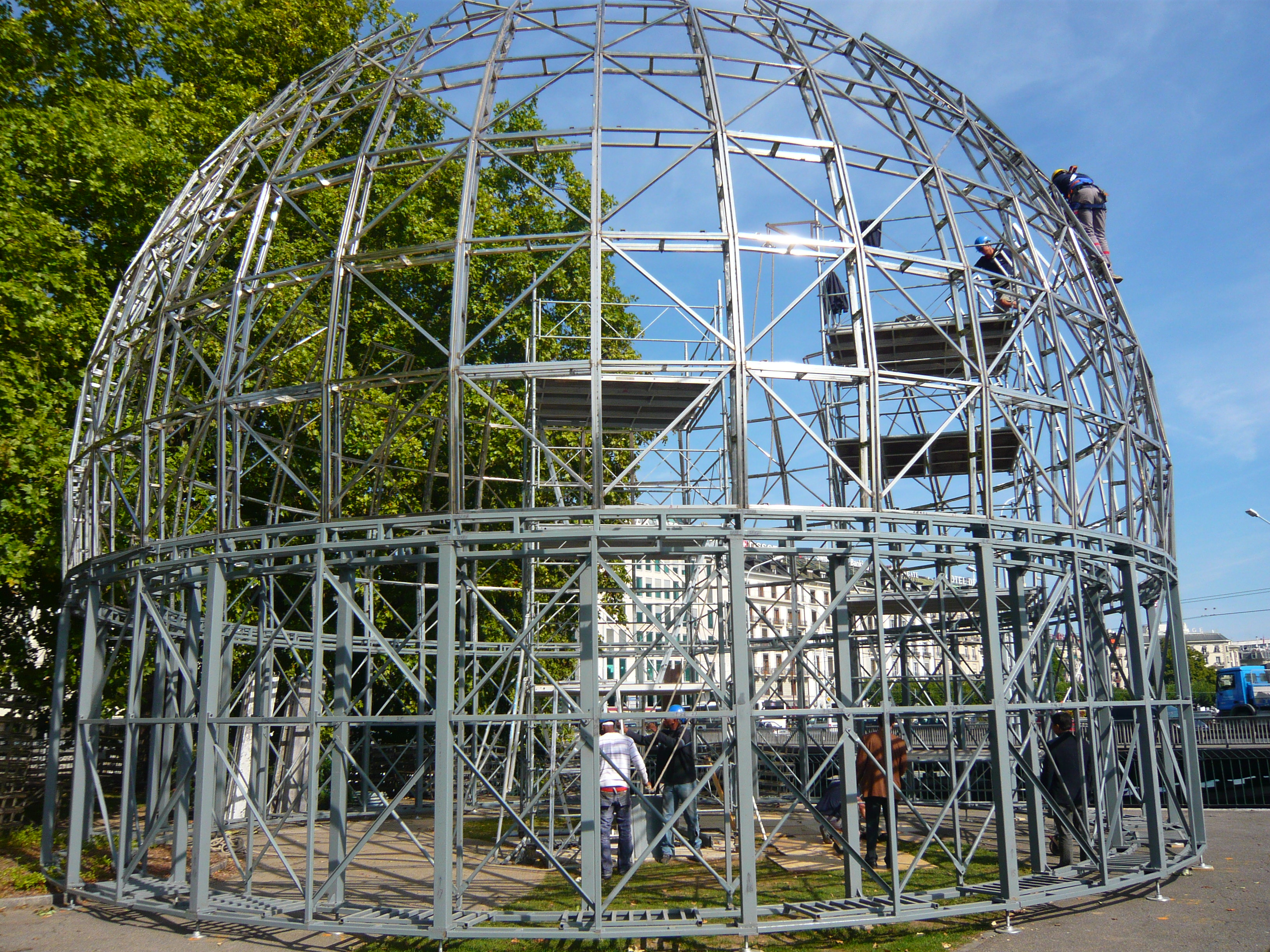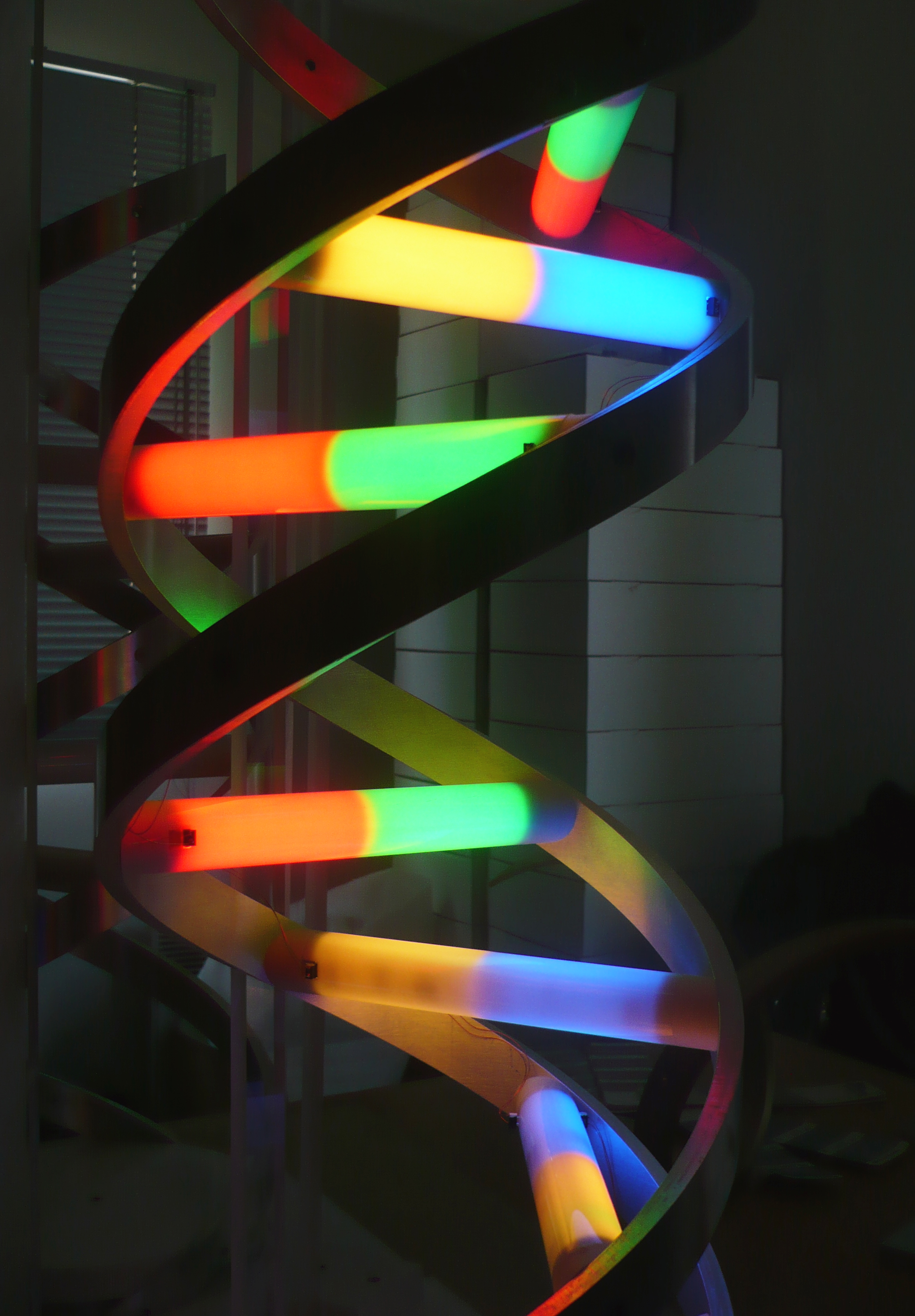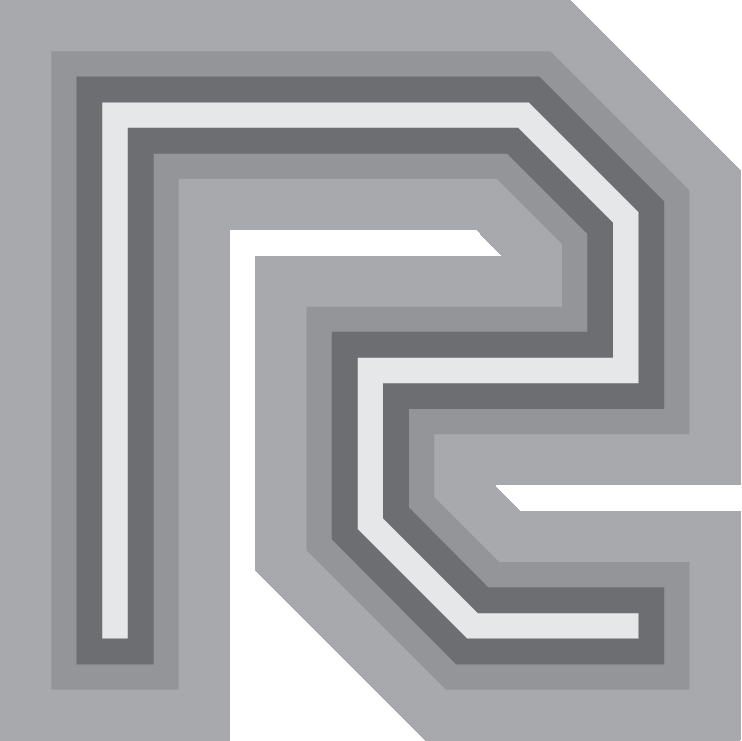Le Génome Voyage
au Cœur du Vivant
Geneva
au Cœur du Vivant
Geneva
A very spectacular exhibition created for the celebration of the 175th anniversary of UNIGE, the University of Geneva
Project
Le Génome Voyage au Cœur du Vivant
Location
Iles Rousseau, Geneva, Switzerland
Category
Temporary exhibition
Opening
September 2009
Client
UNIGE, scientific expertise
Prof. Jean-Dominique Vassali, Rector of the University of Geneva
Prof. Stylianos E Antonarakis, Dr. Didier Raboud, General Secretary,
Dr. Céline Brockmann, Projet Manager UNIGE
Surface m²
232 m2
Scenographic cost € HT
2.600.000 €
Scope of work
Technical managementLighting designAudiovisual and multimedia engineering Show control CFO/CFA
Partners
Scenography : Atelier Confino
Sculpture technical concept : Serge Gaume SGPAI
Audiovisual production and biomedical animation : Drew Berry
Audiovisual integration : Habegger SA
Lighting integration : Habegger SA
For this exciting journey to the heart of life and to better perceive the immensity of the genome, important and complex computer and technical means have been developed:
The construction of a domeConcept design of a dome 14m in diameter. A second dome, internal with a diameter of 12 m, is a projection screen. Construction and first assembly in China. Assembly on Rousseau Island in one week under the supervision of Chinese engineers. The building meets the strict standards in force in Geneva, notably a resistance to winds of about 150 km/h and to the weight of snow. Architect Li Yao. Construction Haotian. Assembly Apelec.
The construction of a dome
Concept design of a dome 14m in diameter. A second dome, internal with a diameter of 12 m, is a projection screen. Construction and first assembly in China. Assembly on Rousseau Island in one week under the supervision of Chinese engineers. The building meets the strict standards in force in Geneva, notably a resistance to winds of about 150 km/h and to the weight of snow. Architect Li Yao. Construction Haotian. Assembly Apelec.
The Light Journal
A luminous journal started on Monday, the 12th of October 2009, reads, in real time for 94 days, the entire database used by geneticists around the world since 2003. This database contains the 3 billion 200 million signs of all the genes. Designated by the letters "A, T, G, C, A, N", they constitute the DNA of the human being. Each letter displayed "A, T, G, C, A, N", is associated with a colored block. This pad moves at exactly the same speed as its associated letter. The speed of display of the luminous newspaper varies from 2,7 characters per second at the opening hours, to 698 characters per second at night, that is to say a variation of 1.5 km/h to 341 km/h. The choice of the speed is done by adjusting the time necessary to display a character. The basic step is 5.6 µs. and the range of choices is from 256 to 65 535 steps, that is to say from 1.4 ms to 0.367 s per character. The newspaper is broken down into 39 strips of 920mm, that is to say a total rollout of 35 880 mm. To date, there was no computer system to sort, manage and display in real time all the necessary information among the database of 3 200 000 000 values. It was necessary to call upon the community of open source programmers. A solution was found by applying to our system, in a derived form, the codec that allows to display on the web the huge database that Wikipedia represents. The device of the luminous newspaper is completed by the installation of an information display. This display gives in reference the date and time of the reading of the first sign, the date and time of the current day and the number of signs read in real time. It displays the scrolling speed, the time necessary at this speed to read the entire genome and also the speed that our body takes to copy it, i.e. 20 minutes. Finally, it allows the visitor to see the chromosome he is reading. Realization Elco, programming Marcus Abt vvvv.org.
The DNA Sculpture
The luminous sculpture, which constitutes the central element of the dome, is visible on 360°. It shows the double helical ribbon where our code is inscribed. It is a model representation of DNA replication, a permanent activity that takes about twenty minutes. It is connected to an interactive terminal where the visitor asks questions and launches different light sequences that illustrate complicated models, such as those of our genetic material. The sculpture, surrounded by a large transparent cylinder, six meters high and 0.9 meters in diameter, weighs about 1 ton. It is posed on a technical base and of setting at distance of 2m. In its conception and its realization, the sculpture ADN is an assembly of detour of industrial application of high technology. The material of the 4 sheets of 10mm which compose the cylindrical envelope of the sculpture is in transparent polymethyl methacrylate (abbreviated in PMMA). These sheets out of industrial standards, required the construction of a specific mold of 3 m by 1.5m. The curvature of the 4 covers is obtained by steaming steps. For such monobloc surfaces, the exact coefficient of expansion after the oven baths is unknown, both in terms of obtaining a perfect circumference and the expected surface. An infinite percentage variation would have resulted in the loss of a large amount of raw material. We had only one throw.
A double twist coming from the top, made of an electrically conductive material, winds up to a diameter of 20 cm and a height of 3 meters, and then splits up to a height of 3 meters, also twisted. These spiral struts form the famous DNA helix discovered by Crick and Watson. Made of pure aluminum, their production is also unique. Their cutting was made with a 5 axis milling machine (A 5 axis milling machine always has 3 linear axes - X, Y, Z - and 2 rotary axes to choose from - A,B,C -) in other words the cutting is directly made in 3 dimensions. This exclusive technique is mainly used in the aeronautical industry. Inside the twisted uprights are fixed bars integrating the luminous elements. These 160 luminous bars spaced 8 cm apart are individually controlled by half bar in order to make the succession of colors representing the G, T, C, A or N genes flow from top to bottom or from bottom to top. A bar consists of a strip of several high quality "RGB" leds. These leds and their embedded multiplexed electronics are fixed on transparent silicone, the whole inserted in a polycarbonate diffusing tube whose composition and realization to measure were particularly studied in order not to project the shades created by the internal bars. The light is therefore perfectly homogeneous over 360°. Twenty or so "floating" half-bars become denser as they approach the free strand of the lower twists. These half-bars are of the same nature and functionality as those integrated in the twists. All the boards and microprocessor controlling the leds have been developed specifically for this application.
Each twisted strand is respectively one of the positive or negative electrically conductive poles. All the control information, colors, luminous intensities or temporizations are conveyed by one and only one small copper wire which circulates from bar to bar. To make it as invisible as possible, it has been painted by hand with a small brush, silver color. The electronics of the bars was specially studied for the sculpture, in order to answer the imperative of encumbrance and luminosity of the project. Each bar is equipped with 12 high brightness RGB leds divided into two groups of 6, separated by a partition. The leds are controlled by a microcontroller with pulse width modulation, to allow a wide variety of color and brightness. All the bars are connected in parallel on an industrial communication network of RS485 type. They each receive a frame in which they each take the information intended for them.
The frame also contains all the values of color, flashing and brightness. The frame is generated by a specific electronic box. It contains a microcontroller card which ensures the interface between the lighting control and the bars. A specific communication protocol allows to take control of all the functions of the sculpture, and to control 8 predefined light sequences used by an interactive terminal.
The sculpture is: 170 microcontrollers, 2000 RGB Leds and .... hours of work !!!! Realisation : SGPAI, PROTOTEC, DIVERSIT
The Show Control
The whole permanent show inside and outside the dome is automated and controlled in real time. We used the Open source vvvv -https://vvvv.org/
The exhibition is a deep dive in the heart of the cell nucleus.
A dome of 14 meters in diameter extrapolates the nucleus.The dome is located on the island Rousseau right in the center of Geneva.
Inside the dome, a 360 ° projection immerses the visitor in the fantastic world unique to each individual identity, the Genome. The DNA filaments gently swaying above heads, the double helix copy at the center of the hall in the form of a large light sculpture. The world premiere of an animated log paper shows item by item, all of this message which consists of 3.2 billion marks, GTCA. The scenography invites the visitor to a playful discovery of the genome, its essential role in the history of life and its importance in today and tomorrow’s medicine
For the best perception of this exciting journey through the hearth of the living, major coding and sophisticated techniques have been developed and implemented.
A dome of 14 meters in diameter extrapolates the nucleus.
For the best perception of this exciting journey through the hearth of the living, major coding and sophisticated techniques have been developed and implemented.









